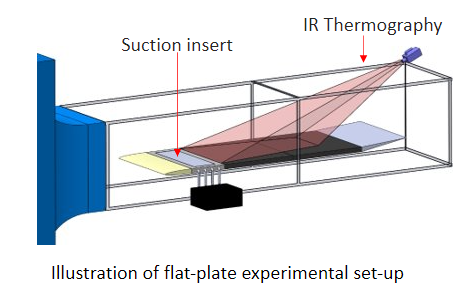Experiments on LFC: Flat-plate with suction insert
- Closed-circuit, low-speed wind tunnel
- Wind speed up to 55 m/s
- Infra-red thermography technique to determine transition location

Key results:
- Boundary layer suction decay TS instabilities, and delay the laminar-to-turbulent transition, extending the laminar flow region on flat-plate
- With increasing in suction, the transition location on the flat-plate moves downstream
- Optimal local suction is around |𝐶𝑞|>0.5×10−3〖|C〗_q |>0.5×10^(-3)
- for |𝐶𝑞|>1×10−3 or 〖|C〗_q |>1×10^(-3 )transition location converged asymptotically

Laminar-to-turbulent transition (without suction)
Re = 3 - 6 million

Laminar-to-turbulent transition as function of suction magnitute, Re = 7 million

Read more:
Grappadelli, M. C., Scholz, P., Radespiel, R., and Badrya, C., Experimental investigations of boundary layer transition on a flat plate with suction, AIAA Scitech 2021 Forum, January 2021. DOI: 10.2514/6.2021-1452
Experiments on LFC: HLFC wing with suction insert
- HLFC wing with suction insert on the upper surface
- Wing characteristics (i.e.: laminar bucket, pressure curve)
- Drag reduction due to BL suction
- Laminar-to-turbulent transition line
- Wind speed: 30- 55 m/s; 0.5 m chord; 𝑅𝑒=0.1−1.6 𝑚𝑖𝑙𝑙𝑖𝑜𝑛Re=0.1-1.6 million
- Drag reduction up to 30% due to BLS
Illustration of HLFC wing experimental set-up

HLFC wing shape with BLS

HLFC wing characteristics at Re = 1 million

Read more:
Grappadelli, M. C., Sudhi, A., Radiespiel, R., and Badrya, C., Experimental Study of a Wing with Hybrid Laminar Flow Control Application, AIAA Aviation Forum 2022, Chicago, 6/27 -7/1/2022
Experiments on LFC: A320 Fin
- Concept verification:
- large scale WT demonstration on relevant aircraft components
- A320-like Vertical Tail Plane (VTP) in DNW-LLF with TSSD suction nose
- Leading edge sweep 40.38°, Re = 22 106 (Transition w/o suction at x/c = 0.03 results from CFI)
- BLS necessary at high sweep angles and Reynolds numbers
- Tailored Skin Single Duct (TSSD) concept (DLR): Variable suction
- ALVAR project (cleansky project in collaboration with DLR and TUBS)
Fin A320 with suction insert model

TSSD suction layout

Key results:
- Laminar region extended to ~40%
- Turbulent wedge related to indentation near leading edge
- Laminar region highlighted by green dot vanishes when lowering plenum pressure
Infrared measurements of transition location

Read more:
-
Barklage, A., Römer, U., Bertram, A., Bekemeyer, P., Himisch, J., Radespiel, R., and Badrya, C., Analysis and Uncertainty Quantification of a Hybrid Laminar Flow Control System. AIAA Journal, Volume 60, https://doi.org/10.2514/1.J061745
-
Barklage, A., Römer, U., Seitz, A., Horn, M., Radespiel, R., Scholz, P., Badrya, C., Validation of Suction Velocity Analysis for Active Laminar Flow Control with Uncertainties, Journal Article, AIAA Journal, p.1, https://arc.aiaa.org/doi/abs/10.2514/1.J062374
-
Seitz, A., Horn, M., Barklage, A., Scholz, P., Badrya, C. and, Radespiel, R., Wind Tunnel Verification of Laminar Boundary Layer Control TSSD Concept, AIAA Aviation Forum 2022, Chicago, 6/27 -7/1/2022.
